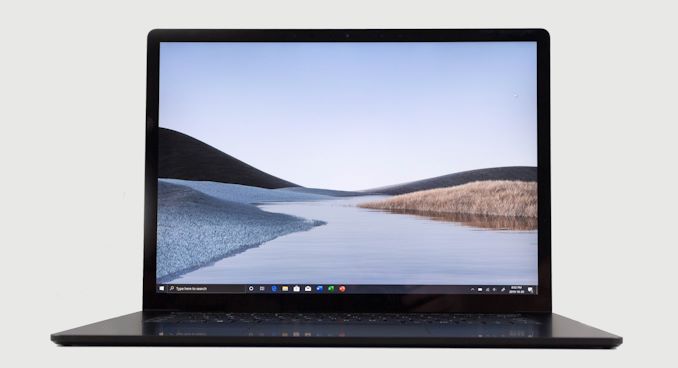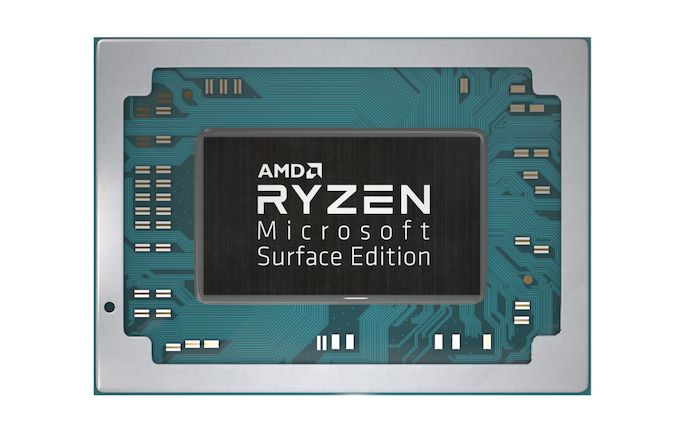The Microsoft Surface Laptop 3 Showdown: AMD's Ryzen Picasso vs. Intel's Ice Lake
by Brett Howse & Andrei Frumusanu on December 13, 2019 8:30 AM ESTFinal Words
Two laptops. Two platforms. It is rare to have a chance to see a manufacturer offer such equal footing to both AMD and Intel by outfitting a premium laptop with processors from both. It represents a rare opportunity to get to test the latest processors from AMD and Intel in a laptop in such an apples-to-apples fashion.
In the laptop space, design, cooling, and a manufacturers requirements can play a big part in how a particular chip performs, thanks to adjustable power level settings, surface temperature adjustments, and more. We have seen the lowest tier CPU outperform the highest tier CPU just by the virtue of a better cooling system, so to have processors from AMD and Intel, both of which launched in 2019, in the same chassis is a wonderful opportunity.
There aren’t too many ways to sugar coat the results of this showdown though. AMD’s Picasso platform, featuring its Zen+ cores and coupled with a Vega iGPU, has been a tremendous improvement for AMD. But Intel’s Ice Lake platform runs circles around it. Sunny Cove cores coupled with the larger Gen 11 graphics have proven to be too much to handle.
On the CPU side, no one should be too surprised by the results. We've already seen on the desktop that AMD’s Zen+ cores were competitive, but slightly slower than the previous Skylake platform; and the new Sunny Cove microarchitecture from Intel is a big step forward in terms of IPC for Intel. On purely CPU based tasks, Ice Lake really stretched its legs, and despite this being a 3.9 GHz chip, in single-threaded SPEC 2017, it managed to come very close to a 5.0 GHz Core i9-9900K with a massively higher TDP. Zen+ is outclassed here, and that showed in the benchmark results, and especially in the benchmark time. On our 8-thread SPEC 2017 run, the Ice Lake platform finished just a hair over two hours ahead of Picasso.
But things fare better for AMD on the GPU side of matters. Even though Intel has certainly closed the gap with Ice Lake's iGPU, AMD seems to continue to hold an advantage, especially on the 11 Compute Unit Ryzen Surface Edition processor found in the Surface Laptop 3. Intel has dedicated a lot more die area to the GPU and the results put them almost on equal footing with the Vega based GPU on Picasso. On the more complex GPU tasks, AMD tends to have a slight lead, and AMD’s low-level driver support also seems to benefit them on DirectX 12 based tasks. But, Ice Lake’s GPU is helped by the much quicker CPU it is coupled to, so depending on the specific test it can be even quicker.
Ice Lake does all of this with much better power efficiency as well. Overall battery life is quite a bit longer, and idle power draw is notably lower as well. Case in point: at minimum screen brightness, the Ice Lake system was pretty much only sipping power, drawing around 1.7 Watts, versus the 3.0 Watts for the AMD system.
It was fantastic to see AMD get a design win in a premium laptop this year, and the Surface Laptop 3 is going to turn a lot of heads over the next year. AMD has long needed a top-tier partner to really help its mobile efforts shine, and they now have that strong partner in Microsoft, with the two of them in a great place to make things even better for future designs. Overall AMD has made tremendous gains in their laptop chips with the Ryzen launch, but the company has been focusing more on the desktop and server space, especially with the Zen 2 launch earlier this year. For AMD, the move to Zen 2 in the laptop space can’t come soon enough, and will hopefully bring much closer power parity to Intel’s offerings as well.
Meanwhile for Intel, Ice Lake has been years in the making, and, after a long delay, it is finally here. After digging into the platform in-depth, it’s clear that Ice Lake is an incredibly strong offering from Intel. The CPU performance gains are significant, particularly because they were made in the face of a CPU frequency deficit. But the biggest gains were on the GPU side, where Intel’s Gen 11 GT2 in its full 64 Execution Unit configuration is likely the biggest single increase in GPU performance since they started integrating GPUs. It pulls very close to AMD’s Vega, closing the gap in performance to almost zero.
2019 has been a big year in the laptop space, with both Intel and AMD bringing new tools to the game. 2020 should be just as exciting, and if we’re lucky, we’ll get another chance to do this all over again.













174 Comments
View All Comments
MBarton - Monday, December 30, 2019 - link
Agreed. Even the outlook for 2020 server ICL has vanished from Intel's presentations. If they can't get working server parts out, there definitely won't be a 10nm desktop part in 2020.deil - Monday, December 16, 2019 - link
I just wonder why...16 GB Dual-Channel DDR4-2400 16 GB Dual-Channel LPDDR4X-3733
AMD gains A LOT from faster ram, what they get? cheappest....
Brett Howse - Monday, December 16, 2019 - link
That's all that Picasso supportseastcoast_pete - Wednesday, December 18, 2019 - link
That is why I am more upset with AMD not putting their best foot forward on mobile. A mobile APU based on Zen2 in 7 nm with Navi-based graphics and an LPDDR4 or LPDDR5 capable memory controller would have given Intel's Ice Lake a real challenge. Instead, AMD is a full generation behind. Ironic, as it's the other way around for desktops.MBarton - Monday, December 30, 2019 - link
Why would a cash-strapped AMD "put their best foot forward" in the mobile segment. It's the lowest profit market of the three. They need profit margins and server/HEDT are FAR more profitable than mobile.MutualCore - Monday, December 16, 2019 - link
Why nothing about SSD performance? This is a critical point for people that need to copy large amounts of data.derstef - Wednesday, December 18, 2019 - link
"DDR4-2400" vs "LPDDR4X-3733" ... fair comparision on the GPU side of things? I dont think so.Butterfish - Friday, December 20, 2019 - link
Your argument is irrelevant. Both are using the best possible RAM they supported. It is AMD’s fault to recycle old chip with outdated spec. We are comparing mobile platform (laptop), not desktop. Everything is highly integrated with CPU influences GPU performance. As both laptops are house in the same cooling solution it is a fair comparison to see which platform is faster in various task.maroon1 - Sunday, January 12, 2020 - link
AMD does not support LPDDR4XAnsley11 - Wednesday, December 18, 2019 - link
$2000, you've got to be kidding me! Why would anyone waste there money on these? I can get a $1000 desktop then can blow these away, and get a couple hundred dollar tablet to do the tablet stuff. Heck, I could probably get both for under $1000 if I shop around and am smart with my choices. People waste FAR too much money on unnecessary tech.